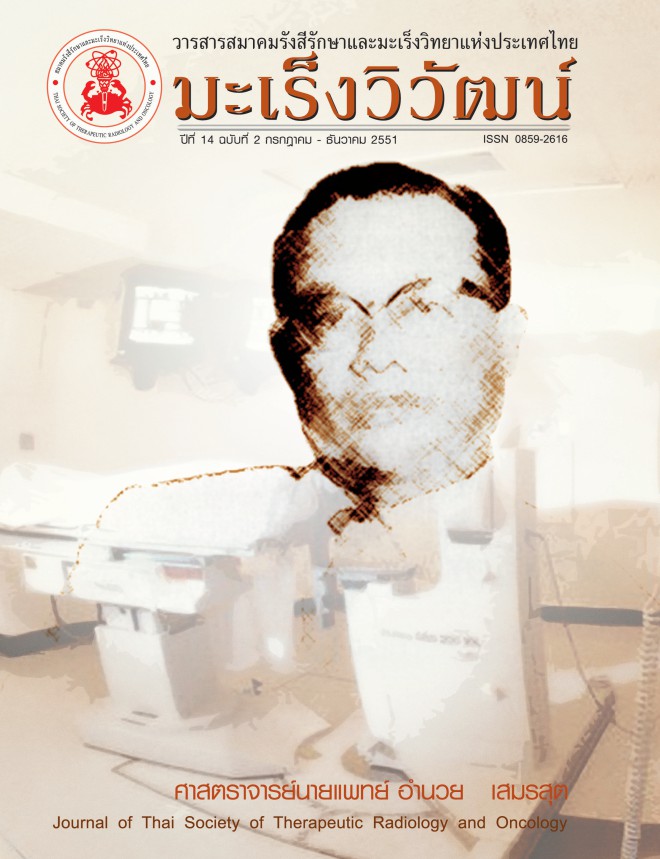การใช้ปัจจัยพยากรณ์โรคและปัจจัยพยากรณ์ ผลการรักษาที่เหมาะสมของมะเร็งเต้านม
Abstract
มะเร็งเต้านมเป็นมะเร็งที่พบได้บ่อยและพบได้มากขึ้นเรื่อยๆ ทั่วโลก จากพัฒนาการและการนำ แมมโมแกรมมาใช้ตรวจคัดกรองหาโรคมะเร็งในระยะแรกเริ่มร่วมกับการเข้าถึงการรักษาเสริมด้วยยาที่ มีประสิทธิภาพที่แพร่หลายส่งผลให้ผู้ป่วยมะเร็งเต้านมมีโอกาสหายขาดและรอดชีวิตในอัตราที่เพิ่มขึ้น เรื่อยๆ (1) แม้ว่าผู้ป่วยมะเร็งเต้านมส่วนใหญ่ที่พบสามารถให้การรักษาหายขาดด้วยการผ่าตัดเอาก้อน มะเร็งออกร่วมกับการให้รังสีรักษาเสริมและไม่ได้ประโยชน์จากการให้ยารักษาเสริมใดๆ ตามมาอีกแต่ ปัญหาที่สำคัญมากที่สุดอย่างหนึ่งในการดูแลรักษาผู้ป่วยมะเร็งเต้านมระยะแรกเริ่มหลังการผ่าตัดคือการ พยากรณ์โรคที่แม่นยำที่จะชี้ชัดว่าผู้ป่วยคนไหนที่จะมีโรคกลับเป็นซ้ำอย่างแน่นอนถ้าไม่ให้ยารักษาเสริม ซึ่งจะได้เลือกที่จะให้ยาแก่ผู้ป่วยดังกล่าวเท่านั้น แต่ด้วยข้อจำกัดของความรู้และเทคโนโลยีในการพยากรณ์ โรคที่จำเพาะกับบุคคลทำให้เราต้องเลือกที่จะให้ยารักษาเสริมแก่ผู้ป่วยส่วนใหญ่แทบจะทุกรายจากการ ประเมินด้วยการใช้ปัจจัยพยากรณ์โรค (prognostic factors) ว่าผู้ป่วยมีความเสี่ยงที่คุ้มค่ากับการรักษา และเลือกให้ยารักษาเสริมด้วยยาเคมีบำบัด ยาต้านฮอร์โมนหรือ ยาต้าน HER-2 (trastuzumab) โดยอาศัย ข้อมูลที่ได้จากปัจจัยพยากรณ์การตอบสนองต่อการรักษา (predictive factors) ทั้งนี้เป็นที่ทราบกันดีและ ยอมรับข้อจำกัดว่าผู้ป่วยบางรายอาจได้ยาเกินความจำเป็นและการให้ยารักษาเสริมก็ไม่ได้ป้องกันการ กลับเป็นซ้ำของโรคได้ทุกราย
References
Henry NL, Hayes DF. Uses and abuses of tumor markers in the diagnosis, monitoring, and treatment of primary and metastatic breast cancer. Oncologist 11:541-52, 2006.
Isaacs C, Stearns V, Hayes DF. New prognostic factors for breast cancer recurrence. Semin Oncol 28:53-67, 2001.
Hayes DF, Trock B, Harris AL. Assessing the clinical impact of prognostic factors: when is "statistically significant" clinically useful? Breast Cancer Res Treat 52:305-319, 1998.
Hayes DF, Trock B, Harris AL. Assessing the clinical impact of prognostic factors: when is "statistically significant" clinically useful? Breast Cancer Res Treat 52:305-319, 1998.
Paik S, Shak S, Tang G et al. A multigene assay to predict recurrence of tamoxifen-treated, node-negative breast cancer. N Engl J Med 351:2817-2826, 2004.
Fisher B, Dignam J, Wolmark N et al. Tamoxifen and chemotherapy for lymph node-negative, estrogen receptor-positive breast cancer. J Natl Cancer Inst 89:1673-1682, 1997.
Fisher B, Costantino J, Redmond C et al. A randomized clinical trial evaluating tamoxifen in the treatment of patients with node-negative breast cancer who have estrogen-receptor-positive tumors. N Engl J Med 320:479-484, 1989.
Paik S, Tang G, Shak S et al. Gene expression and benefit of chemotherapy in women with node-negative, estrogen receptor-positive breast cancer. J Clin Oncol 24:3726-3734, 2006.
van 't Veer LJ, Dai H, van de Vijver MJ et al. Gene expression profiling predicts clinical outcome of breast cancer. Nature 415:530-536, 2002.
van de Vijver MJ, He YD, van't Veer LJ et al. A gene-expression signature as a predictor of survival in breast cancer. N Engl J Med 347:1999-2009, 2002.
Buyse M, Loi S, van't Veer L et al. Validation and clinical utility of a 70-gene prognostic signature for women with node-negative breast cancer. J Natl Cancer Inst 98:1183-1192, 2006.
Hayes DF, Bast RC, Desch CE et al. Tumor marker utility grading system: a framework to evaluate clinical utility of tumor markers. J Natl Cancer Inst 88:1456-1466, 1996.
McShane LM, Altman DG, Sauerbrei W et al. REporting recommendations for tumour MARKer prognostic studies (REMARK). Br J Cancer 93:387-391, 2005.
Harris L, Fritsche H, Mennel R, et al. American Society of Clinical Oncology 2007 update of recommendations for the use of tumor markers in breast cancer. J Clin Oncol 25:5287-312, 2007.
Downloads
Published
How to Cite
Issue
Section
License
บทความที่ได้รับการตีพิมพ์เป็นลิขสิทธิ์ของวารสารมะเร็งวิวัฒน์ ข้อความที่ปรากฏในบทความแต่ละเรื่องในวารสารวิชาการเล่มนี้เป็นความคิดเห็นส่วนตัวของผู้เขียนแต่ละท่านไม่เกี่ยวข้องกับ และบุคคลากรท่านอื่น ๆ ใน สมาคมฯ แต่อย่างใด ความรับผิดชอบองค์ประกอบทั้งหมดของบทความแต่ละเรื่องเป็นของผู้เขียนแต่ละท่าน หากมีความผิดพลาดใดๆ ผู้เขียนแต่ละท่านจะรับผิดชอบบทความของตนเองแต่ผู้เดียว




